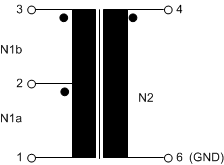SLASEC8C February 2017 – February 2023 PGA460-Q1
PRODUCTION DATA
- 1 Features
- 2 Applications
- 3 Description
- 4 Revision History
- 5 Pin Configuration and Functions
-
6 Specifications
- 6.1 Absolute Maximum Ratings
- 6.2 ESD Ratings
- 6.3 Recommended Operating Conditions
- 6.4 Thermal Information
- 6.5 Internal Supply Regulators Characteristics
- 6.6 Transducer Driver Characteristics
- 6.7 Transducer Receiver Characteristics
- 6.8 Analog to Digital Converter Characteristics
- 6.9 Digital Signal Processing Characteristics
- 6.10 Temperature Sensor Characteristics
- 6.11 High-Voltage I/O Characteristics
- 6.12 Digital I/O Characteristics
- 6.13 EEPROM Characteristics
- 6.14 Timing Requirements
- 6.15 Switching Characteristics
- 6.16 Typical Characteristics
-
7 Detailed Description
- 7.1 Overview
- 7.2 Functional Block Diagram
- 7.3
Feature Description
- 7.3.1 Power-Supply Block
- 7.3.2 Burst Generation
- 7.3.3 Analog Front-End
- 7.3.4 Digital Signal Processing
- 7.3.5 System Diagnostics
- 7.3.6
Interface Description
- 7.3.6.1 Time-Command Interface
- 7.3.6.2
USART Interface
- 7.3.6.2.1 USART Asynchronous Mode
- 7.3.6.2.2 One-Wire UART Interface
- 7.3.6.2.3 Ultrasonic Object Detection Through UART Operations
- 7.3.6.3 In-System IO-Pin Interface Selection
- 7.3.7 Echo Data Dump
- 7.3.8 Low-Power Mode
- 7.3.9 Transducer Time and Temperature Decoupling
- 7.3.10 Memory CRC Calculation
- 7.3.11 Temperature Sensor and Temperature Data-Path
- 7.3.12 TEST Pin Functionality
- 7.4 Device Functional Modes
- 7.5 Programming
- 7.6 Register Maps
- 8 Application and Implementation
- 9 Device and Documentation Support
- 10Mechanical, Packaging, and Orderable Information
Package Options
Mechanical Data (Package|Pins)
- PW|16
Thermal pad, mechanical data (Package|Pins)
Orderable Information
8.2.1.2.4 Transformer Turns Ratio
A center-tap transformer is typically paired with the transducer to convert a DC voltage to a high-sinusoidal AC voltage. The center tap is a contact made to a point halfway along the primary winding of the transformer. The center tap is supplied with the DC voltage that is then multiplied on the secondary side based on the turns ratio of the transformer. #T4490914-48 shows the typical pinout of a center-tap transformer where pin 2 is the center tap, pins 1 and 3 are connected to OUTB and OUTA, pin 4 is connected to the positive terminal of the transducer, and pin 6 is connected to ground.
 Figure 8-3 Typical Pinout of Center-Tap Transformer for Ultrasonic Transducers
Figure 8-3 Typical Pinout of Center-Tap Transformer for Ultrasonic TransducersTwo modes to generate the transducer voltage using the center tap transformer are available. These modes are defined as follows:
- Push-pullIn this mode, the two internal low-side switches of the PGA460-Q1 device are used to turn current on and off in two primary coils of the center-tap transformer.
The primary coils have the same number of turns. The rate of change of current in the primary coil generates a voltage in the secondary coil of the transformer, which is connected to the transducer. The direction of current in the primary coils generates voltages of opposite polarity in the secondary coils which effectively doubles the peak-to-peak voltage in the secondary coil.
- Single-endedIn this mode, one low-side switch is used to turn current on and off in the primary of the transformer.
The rate of change of current in the primary coil generates a voltage in the secondary coil of the transformer, which is connected to the transducer. The center tap of the transformer is not required for this mode, and can be left floating. Instead, the reference voltage is connected to an outermost primary-side terminal (pin 3) and either OUTA or OUTB is connected to the other primary-side terminal (pin1).